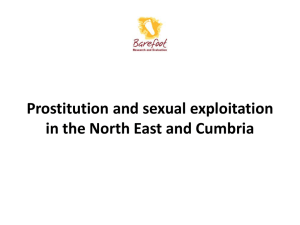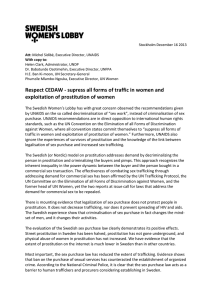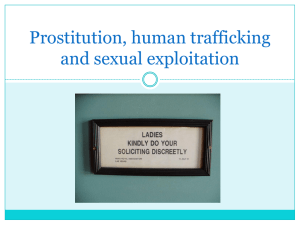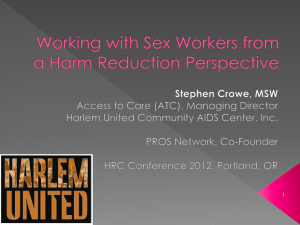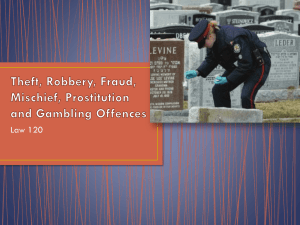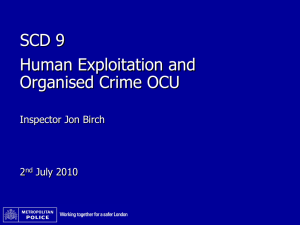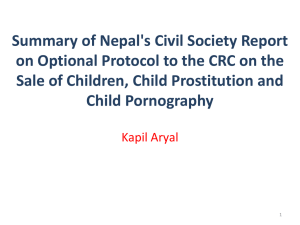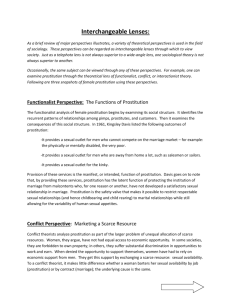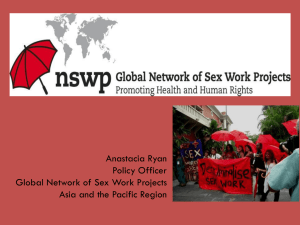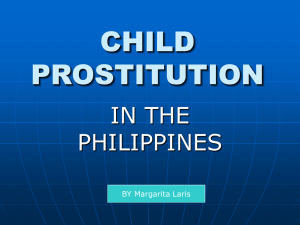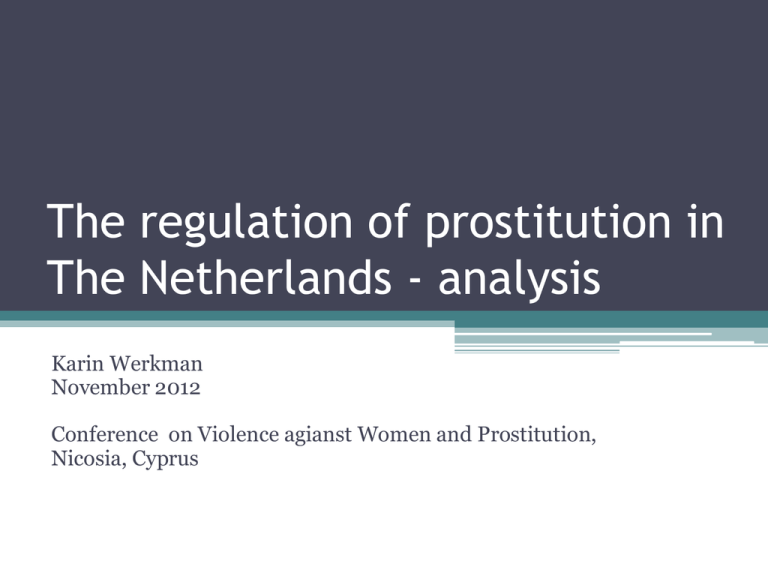
The regulation of prostitution in
The Netherlands - analysis
Karin Werkman
November 2012
Conference on Violence agianst Women and Prostitution,
Nicosia, Cyprus
Belle
Respect
sex workers
all over the world
Lifting of the ban on brothels 2000
≠ legalisation of prostitution
Lifting of the ban on brothels 1911
= legalisation of brothels and pimping
Introduction of distinctions:
forced / voluntary prostitution;
prostition / trafficking
Goals:
state control & improvement of ‘working conditions’
Six main goals:
1. the control of the exploitation of voluntary
prostitution;
2. the improvement of the combat against the
exploitation of coerced prostitution;
3. the protection of minors from sexual abuse;
4. the protection of the position of prostitutes;
5. to disentangle the ties between prostitution
and criminal peripheral phenomena;
6. to reduce the scale of prostitution by illegal
foreign nationals.
Impact - studies
Baseline study 1999:
• brothels present in 30% municipalities
Rotterdam 2006:
• > 50% of women ‘work illegally’
• Working illegally =
▫
▫
▫
▫
forced to work;
no residency/illegal status;
minors (<18yrs old);
working in illegal sex establishments.
DSP-Group 2006 on municpalities
•
•
•
•
68% municipalities have policy on brothels
30% brothels in violation of policy past 5 years
49% mention fight human trafficking in policy
6% muncipalities offer exit programmes
Impact – studies. DPS 2006
Evaluation Daalder 2007
6 main goals:
• Voluntary: majority industry outside gov control
• Forced: ‘impossible to comment’
• Minors: ‘scarcely encountered’
• Conditions: emotional well-being decreased on
all accounts; use of sedatives increased; high
demand for exit, but no possiblities
• Separation: ‘impossible to comment’
• Illegals: somewhat succesful: 2004 EU borders
Impact - studies
KLPD 2008 ‘Keeping up appearances’
• Sneep-case
• 50-90% ‘work involuntarily’:
• At least 4,000 women Amsterdam..
RIEC 2010
• Analysis 2,600 advertisements
• 17% advertisements sex industry originate from
licenced brothels
Emergo – Amsterdam 2011
• Half of bussineses in Amsterdam red light
district has one or more managers with criminal
record
Law proposal 2009-present
•
•
•
•
Permits all sex industry
Registration women
Buyers of unregistered women criminalised
Zero-option
• Minimum age 18 – 21 yrs old
• Register suspicion of trafficking
Legalisation = normalisation
• Buyers website:
25,000 women in prostitution
150,000 ‘customer reviews’
500,000 unique visitors
8 million page views
• On 30 October 2012 new ‘world’ record with
3,992 unique visitors at one single moment…
Buyers in the Netherlands
•
•
•
•
•
Openly participate in policy making;
Openly advise the government;
Lobby in parliament;
Assist the police;
Lecture in university, appear on nat TV.
Senate majority and public opinion are opposed to
responsibility for prostitution buyers,
for the police needs support from buyers to fight
human trafficking.. ?
Legalisation = normalisation
• ‘prostitution = sex work’
• Is it work?
• ‘fair trade’ labels
• Sex tourism is tourism.. Advertise unique
attraction on government websites..
• Or paying pimps to leave the city ?
Conclusion
Impact of legalisation:
• Improve women’s lives?
• Fight trafficking?
• Not making things do ‘underground’?
• Normalisation
Solutions:
• Push legalisation further;
• Or punish the buyers?
Opzij enquiry
• 77% support criminalisation of buyers of
underage women / trafficking victims;
• 71% criminalisation of pimping;
• 59% of female respondents disagree that
prostitution is a normal profession and a choice.
Thank you for your attention!

